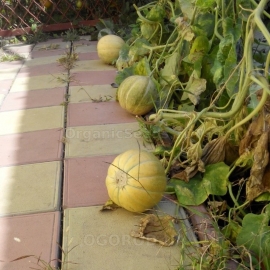


«Cantaloupe» - Organic Melon Seeds
1.14 €
A mid-season variety for open ground and film greenhouses, this melon variety is very demanding on heat, fruits of medium size (1-5 kg), round in shape, orange pulp. delicate, very sweet and juicy, with a pleasant aroma.
-
Heirloom Melon «Cantaloupe» or Thai melon (Cucumis melo var. cantalupensis)
Mid-season variety for open ground and film greenhouses. This melon variety is very heat demanding.
Melons of medium size (1-5 kg), round in shape. The surface of the fruit is creamy white with thin dark green grooves. The pulp is orange. delicate, very sweet and juicy, with a pleasant aroma.
Agrotechnics:
Melon is grown in open ground and greenhouses, on light air and permeable soils. Before sowing, the seeds are treated in a solution of potassium permanganate, then washed with clean water. Sowing approximately in May, when the soil warms up to a depth of 8-10 cm to 15-16 ° C.
Planting scheme 140x50 cm. In greenhouses 70x40 cm, using trellises (fruits can be hung in nets). The seedling method of growing is also used. In this case, the seedlings are planted after the last frost at the age of 3-4 true leaves.
As they grow, the plants form into one stem, removing the lateral shoots and leaving 2-3 ovaries on it (the rest are removed). Further care consists of moderate watering, loosening, dressing and dusting the lashes to protect them from turning over by the wind.
